Medici lions
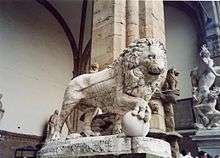
The Medici lions are a pair of marble sculptures of lions, one of which is of ancient origin, the other a 16th-century pendant; both were by 1598[1] placed at the Villa Medici, Rome, and since 1789 have been displayed at the Loggia dei Lanzi, Florence. The sculptures depict standing male lions with a sphere or ball under one paw, looking to the side. The Medici lions have been copied, directly or with variations, in many other locations.
History
A pair of lions were required by Ferdinando I de' Medici, Grand Duke of Tuscany, who had acquired the Villa Medici in 1576, to serve as majestic ornaments for the villa's garden staircase, the Loggia dei leoni. The first lion originates from a 2nd-century[2] marble that was first mentioned in 1594, by the sculptor Flaminio Vacca,[3] by which time it was already in the collection of Ferdinando;[4] Vacca reported that it had been found in the via Prenestina, outside Porta San Lorenzo. According to Vacca, the lion had been a relief, which was carved free of its background and reworked by "Giovanni Sciarano" or Giovanni di Scherano Fancelli, of whom little is now known.[5]
The second was made and signed[6] by Vacca, also in marble, as a pendant to the ancient sculpture at a date variously reported as between 1594 and 1598[2] or between 1570 and 1590.[7][8] The pair were in place at the Loggia dei Leoni in 1598[1] The pendant was made from a capital that had come from the Temple of Jupiter Optimus Maximus.[8]
The Villa Medici was inherited by the house of Lorraine in 1737, and in 1787[2][9][10] the lions were moved to Florence, and since 1789[9] they flank the steps to the Loggia dei Lanzi at the Piazza della Signoria.
The sculptures were replaced by copies at the Villa Medici when Napoleon relocated the French Academy in Rome to the villa in 1803.[11] These copies were made by the French sculptor Augustin Pajou.[10]
 The original Medici lions at the Villa Medici (Giovanni Francesco Venturini 1691)
The original Medici lions at the Villa Medici (Giovanni Francesco Venturini 1691)- The current Medici Lions at the Villa Medici in Rome
- Medici Lion by Augustin Pajou at the Villa Medici
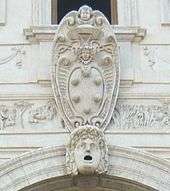 The Medici coat of arms with five balls, above Loggia dei leoni
The Medici coat of arms with five balls, above Loggia dei leoni
Copies
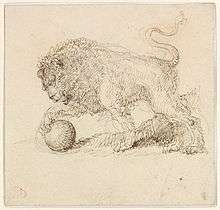
The original Medici lions (1598) are since 1789 standing at the Loggia dei Lanzi, Piazza della Signoria, Florence. There is smaller bronze left-looking sculpture attributed to Italian sculptor Pietro da Barga[12] and the same period.[7] Later copies or replicas include (ordered by first year):
Spain
- Twelve sculptures in bronze by Matteo Bonucelli da Lucca, commissioned in Rome by Velázquez for the Room of Mirrors at the Royal Alcazar of Madrid (1651):
- Four sculptures are now in the Salón del Trono in the Royal Palace of Madrid (since 1764).[13]
- Eight sculptures are now in the Museo del Prado, of which four support the tabletop of Rodrigo Calderón.[13][14]
- Sculptures in Colmenar marble at the Montforte Gardens, Valencia by José Bellver (circa 1860).[15][16]
- Sculptures in marble at the Canalejas Park, Alicante (park created 1886).
Sweden
- Sculpture in bronze in the Royal Swedish Academy of Arts building, Stockholm (before 1735?).[17]
- Sculpture in bronze at the Royal Institute of Art, Stockholm (1995).
- Sculpture in bronze in Nacka, Stockholm (1996).[18][19]
Britain
- Sculptures in lead at Stowe House attributed to John Cheere (around 1755–779). Formerly placed at Stanley Park, Blackpool (1927–2013).[20][21]
- Sculpture in the park of Kedleston Hall, carved by Joseph Wilton (around 1760–70).[22][23]
- Two artificial stone versions are found in the garden of the Osborne House (1845–1851), Isle of Wight.[24]
- Sculptures at the Stanley Park, Blackpool (2013). These were produced, by Rupert Harris Conservation, using casts from the former sculptures which were returned, on loan, to Stowe house in 2013.[25]
Russia and Ukraine
Versions in Saint Petersburg, Russia include:[26]
- The Lion Cascade in bronze at Peterhof Palace (1799–1801).
- Sculptures in marble at the Lobanov-Rostovsky Residence (constructed 1817–20).[27][28]
- Sculptures in bronze at the staircase of the old Mikhailovsky Palace (constructed 1819–25).[29]
- Sculptures at the entrance of Yelagin Palace (completed 1822).
- The Lions at the Dvortsovaya pier in bronze at the Admiralty embankment (1832).
Versions in southern Russia and later Ukraine include:
- Sculptures in marble at the Vorontsov Palace , Odessa (now Ukraine, completed 1830).
- Six pairs of marble lion sculptures at the Voronstov Palace, Crimea (installed in 1848).
- Pair of lion sculptures at Starosinnyi Garden, Odessa (now Ukraine, unknown year).[30]
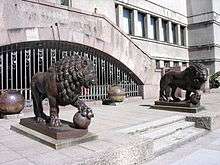
Italy
- Sculptures in marble by Augustin Pajou at the Villa Medici (1803).[11]
Germany
- Four miniature versions surrounding the Akademie- or Löwenbrunnen in the palace garden (1807–1811), Stuttgart.
- Two gilded versions as part of the Lion Fountain in front of Glienicke Palace (1824–26), Berlin.
- Statues at the entrance of Schloss Monrepos, Ludwigsburg (of unknown origin).[31]
Cuba
- Two versions outside the Cathedral de la Purisma Concepción in Cienfuegos (built 1833–69), Cuba.
United States
- The Florentine Lions in cast-iron in the Fairmount Park, Philadelphia (cast in 1849 at the Alexandroffsky Head Mechanical Works, St Petersburg, Russia for Andrew M. Eastwick, originally displayed at Bartram's Garden, 1851–1879, installed at west Fairmount Park in 1887).[32]
- Stone sculptures, Mick and Mack, at McMicken Hall, The University of Cincinnati, Ohio (there since 1904). The pair of lions originally belonged to Jacob Hoffner, a wealthy Cincinnati landowner who bequeathed them to the University upon his death in 1891. They were transported to their current location in 1904.[33]
- The pair of lions on the western end of the eponymous Bridge of Lions in St. Augustine, Florida (constructed 1925–1927, rebuilt 2011–2012).[34]
- Sculpture in limestone at the Museum of Outdoor Arts, Colorado (founded 1981).[35]
Estonia
- The Swedish lion in bronze in Narva, Estonia. A version of one of the Slottslejonen was first erected in 1936 but destroyed 1944 during the German occupation. A sized-down copy of the Medici Lion in the Royal Swedish Academy of Arts was re-erected in 2000.
Lithuania
- Sculptures of lions are in bronze at the staircase of the Vytautas the Great War Museum in Kaunas, Lithuania. They were donated by Lithuanian count Jonas Julius Tiškevičius (1917–1987) in 1938 from his Astravas Manor in Biržai suburb (decorative sculptures of lions that stood at the entrance to the manor were replaced with copies). Sculptures was made in Saint Petersburg's factory commissioned by Lithuanian count Jonas Tiškevčius in the middle of the 19th century.[36]
France
- Several[37] sculptures at the Terrasse des Orangers in Parc de Saint-Cloud, Hauts-de-Seine, Paris (of unknown origin).[38]
Hungary
- Statues at Pétervására, Hungary (of unknown origin).[39]
Close imitations
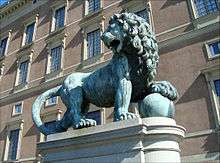
- Sweden: Slottslejonen (Swedish for The Palace Lions) in bronze, by Bernard Foucquet at the Royal Palace, Stockholm (1700–1704).
- United Kingdom: Sculptures in bronze at the Queen's Gate entrance to Royal Victoria Park in Bath (1818–1819).[40]
- Belgium: Lion of Waterloo in iron, by Jean-François Van Geel in Waterloo (1826).
- India: Fitzgerald Bridge statue in Pune, India (1866).
- Spain: The Leones del Congreso: Daoiz y Velarde in bronze at the Congress of Deputies, Madrid, Cast in 1865, installed 1872.[41]
- Finland: Parolan Leijona (Finnish for The Lion of Parola) on a four meter high pedestal in Hattula. Erected in 1868 to commemorate the 1863 visit by Alexander II of Russia.[42]
In popular culture
Downsized copies of the Medici lions are on display in the garden of the Corleone family estate in The Godfather (1972).
See also

Notes
- 1 2 Haskell and Penny 1981:246.
- 1 2 3 "Lions of Firenze". clevermag.com. Clever Magazine.
- ↑ Vacca 1790
- ↑ Haskell and Penny 1981:247–50.
- ↑ "FANCELLI, Giovanni, detto Nanni di Stocco in "Dizionario Biografico"". treccani.it.
- ↑ Haskell and Penny 1981:247.
- 1 2 "The Medici Lion". tomassobrothers.co.uk.
- 1 2 Giovanna Giusti Galardi: The Statues of the Loggia Della Signoria in Florence: Masterpieces Restored, Florence 2002. ISBN 8809026209
- 1 2 borghiditoscana.net
- 1 2 Draper, James David; Pajou, Augustin; Scherf, Guilhem; Louvre, Musée du; N.Y.), Metropolitan Museum of Art (New York (16 March 1998). "Augustin Pajou: royal sculptor, 1730-1809". Metropolitan Museum of Art – via Google Books.
- 1 2 "Rome Off The Beaten Path Tips by von.otter". virtualtourist.com.
- ↑ "Answers - The Most Trusted Place for Answering Life's Questions". answers.com.
- 1 2 "León | Patrimonio Nacional". www.patrimonionacional.es. Retrieved 2016-11-16.
- ↑ "León - Colección - Museo Nacional del Prado". museodelprado.es.
- ↑ "JARDÍN DE MONFORTE (L´HORT DE ROMERO)". visitvalencia.com.
- ↑ TURESPAÑA (23 April 2007). "Monforte Gardens in Valencia, Spain: Historic gardens in Valencia, Spain - spain.info in english". spain.info.
- ↑ "Archived copy". Archived from the original on 24 November 2013. Retrieved 2013-02-10.
- ↑ "Konstverk i Nacka Strand". www.jarlaberg.se. Retrieved 2016-11-16.
- ↑ "Mueller". infobank.nacka.se. Retrieved 2016-11-16.
- ↑ "Stowe House, Buckinghamshire | Projects | WMF Britain". www.wmf.org.uk. Archived from the original on 12 October 2016. Retrieved 2016-11-16.
- ↑ "Medici Lions return to Stowe :: Historic Houses Association". www.hha.org.uk. Retrieved 2016-11-16.
- ↑ "Geograph:: Medicean Lion Statue (C) Trevor Rickard". geograph.org.uk.
- ↑ Historic England. "Details from listed building database (1109087)". National Heritage List for England. Retrieved 30 September 2015.
- ↑ Mawrey, Gillian; Groves, Linden (24 August 2010). "The Gardens of English Heritage". Frances Lincoln – via Google Books.
- ↑ "The Stowe Lions". World Monuments Fund – Britain. Archived from the original on 27 August 2014. Retrieved 20 November 2014.
- ↑ "Львы Дворцовой пристани". Википедия (in Russian). 2016-09-12.
- ↑ "Saint Petersburg encyclopaedia". www.encspb.ru. Retrieved 2016-11-16.
- ↑ http://www.leospb.ru/en/leo.php?id=42
- ↑ "Ошибка на странице". encspb.ru.
- ↑ Commons:File:Starosinnyi Garden.JPG
- ↑ File:Schloss Monrepos Detail3.jpg
- ↑ "Florentine Lions - Philadelphia, PA - Lion Statues on Waymarking.com". waymarking.com.
- ↑ "History of McMicken College, University of Cincinnati". 2013-07-17. Archived from the original on 17 July 2013. Retrieved 2016-11-16.
- ↑ "Lions Restored To St. Augustine Bridge - Jacksonville News Story - WJXT Jacksonville". 2011-07-14. Archived from the original on 14 July 2011. Retrieved 2016-11-16.
- ↑ "Lion's Den Museum Of Outdoors Arts". 2008-09-26. Archived from the original on 26 September 2008. Retrieved 2016-11-16.
- ↑ "Vytauto Didžiojo karo muziejaus sargai sugrįžo". 15min.lt. Retrieved 2016-11-16.
- ↑ At least three visible in File:Parc Saint-Cloud2.jpg.
- ↑ commons:Category:Medici lions at the Château de Saint-Cloud, larva-e.de
- ↑ commons:Category:Statues of lions in Pétervására
- ↑ Renovated in 2007 to include the ball under the paw. Produced around 1818, they were commissioned by Charles Geary Esq, for inclusion in the new Masonic Hall in York Street, Bath, which was opened on 23 September 1819 with great ceremony, by the Grand Master of England, HEH the Duke of Sussex, attended by 800 to 1000 Freemasons in full regalia. ‘The Historic Guide to Bath 1864’ records the event and details "the master's chair stood on a throne of black and white marble, supported by lions, their feet resting on balls." The elaborate building immediately ran into financial trouble and soon closed. In 1842, Geary, having secured the debts and in order to pay them off, sold the hall to the Society of Friends, in whose care it remains, and the elaborate contents (known as ‘The Bath Furniture’) to Loyal Lodge No 251, Barnstable, Devon, where they also remain to this day. The lions, however, did not make the trip, legend suggesting there was no cart available to transport them. They were, therefore, presented to the city and the same ‘The Historic Guide to Bath 1864’ later records "At the side entrances, over the Queen's Gate, leading to the Royal Avenue are Bronzed Lions, presented by Mr. Geary." They were restored in 2007.
- ↑ "Patrimonio Históríco-Artístico. Documental y Bibliográfico.". congreso.es.
- ↑ STT. "Parolan leijona trimmataan kuntoon". savonsanomat.fi.
References
| Wikimedia Commons has media related to Medici lions. |
- Flaminio Vacca, di varie antichità trovate in diversi luoghi della città di Roma, not published until 1790 (noted by Francis Haskell and Nicholas Penny, Taste and the Antique: the lure of classical sculpture, 1500–1900 1981).
- Michel Hochmann: Villa Medici, il sogno di un Cardinale – Collezioni e artisti di Ferdinando de’ Medici, De Luca, 1999, p. 208–11, nos. 37–40, illus. pp. 209–11
- Roberto Manescalchi Il Marzocco / The lion of Florence. In collaborazione con Maria Carchio, Alessandro del Meglio, English summary by Gianna Crescioli. Grafica European Center of Fine Arts e Assessorato allo sport e tempo libero, Valorizzazioni tradizioni fiorentine, Toponomastica, Relazioni internazionale e gemellaggi del comune di Firenze, novembre, 2005.
Coordinates: 43°46′9.13″N 11°15′20.37″E / 43.7692028°N 11.2556583°E
